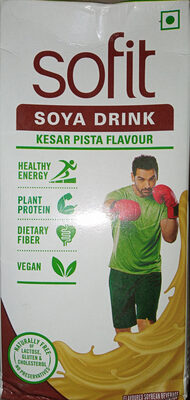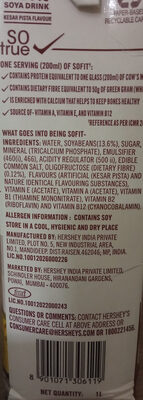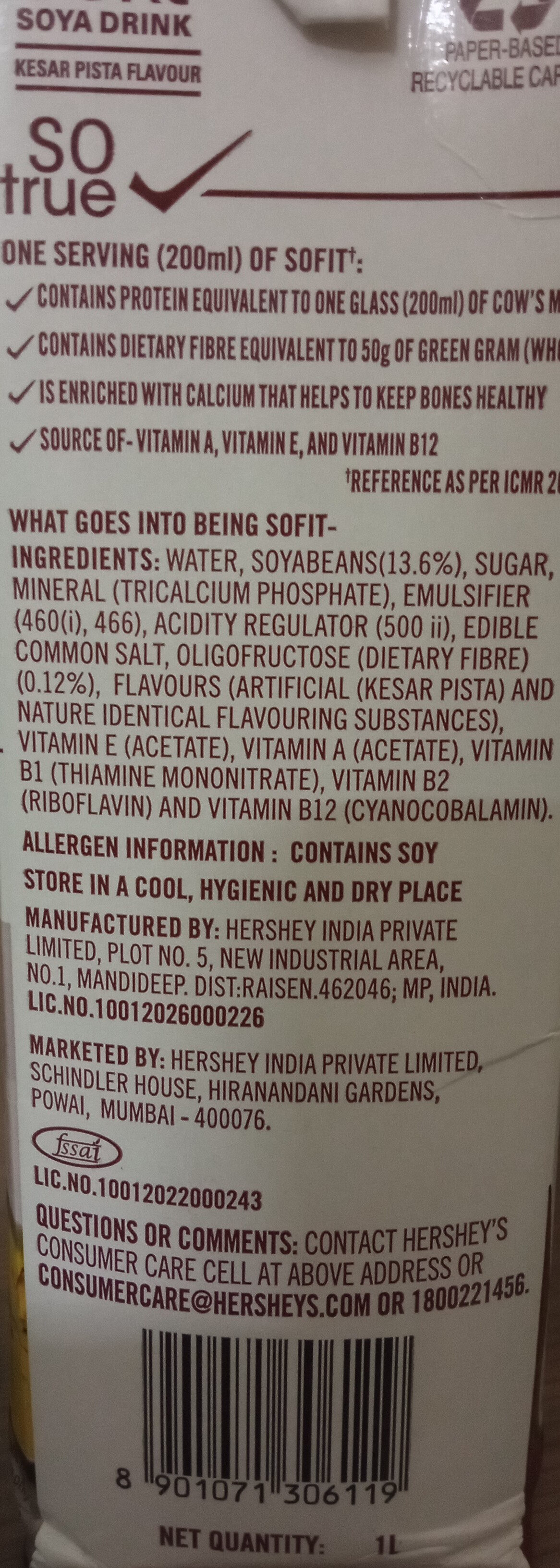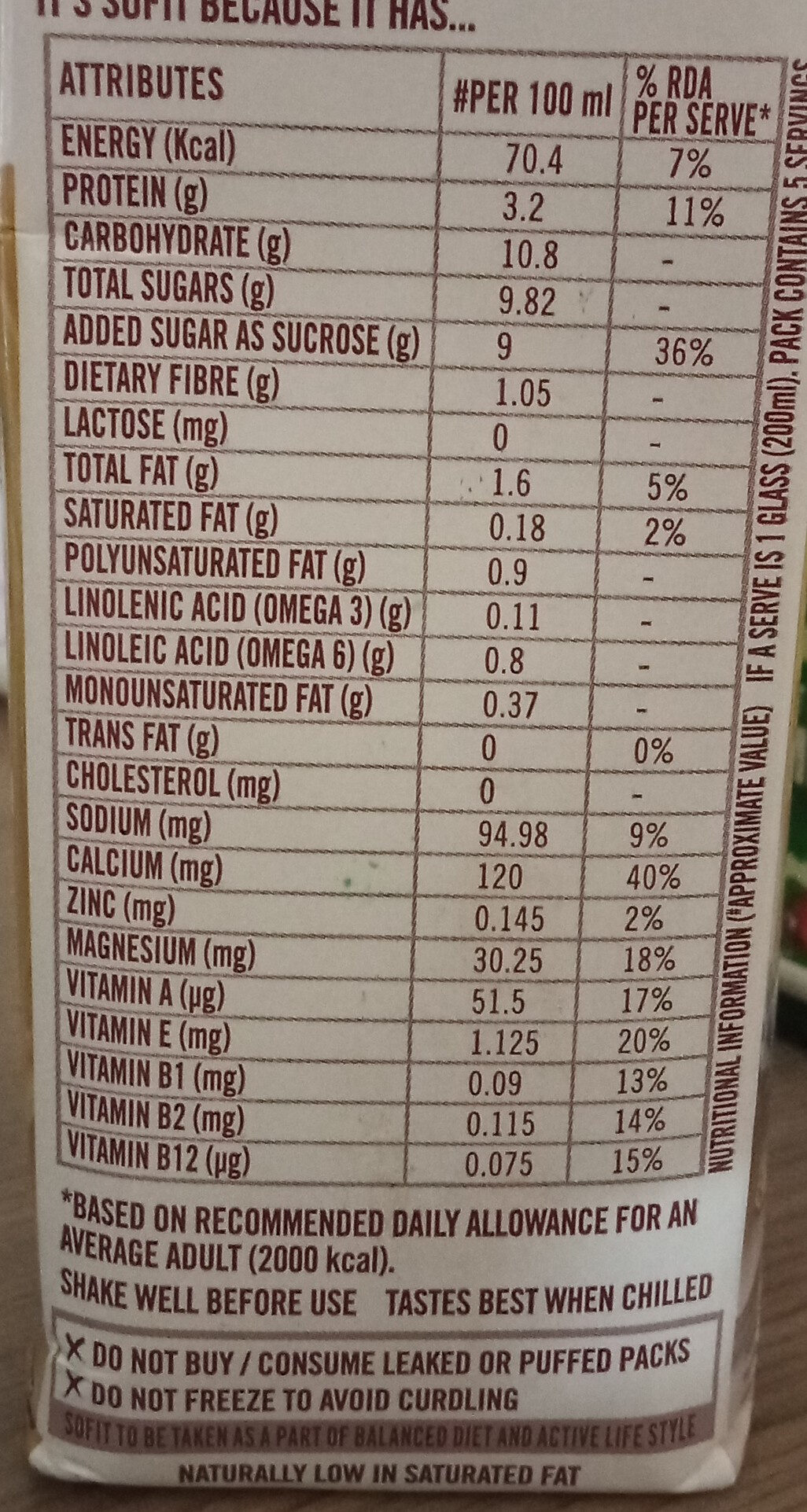Help us make food transparency the norm!
As a non-profit organization, we depend on your donations to continue informing consumers around the world about what they eat.
The food revolution starts with you!
Sofit Soya Drink (Kesar Pista Flavour) - Hershey's India - 1 l
Sofit Soya Drink (Kesar Pista Flavour) - Hershey's India - 1 l
This product page is not complete. You can help to complete it by editing it and adding more data from the photos we have, or by taking more photos using the app for Android or iPhone/iPad. Thank you!
×
Barcode: 8901071306119 (EAN / EAN-13)
Quantity: 1 l
Packaging: Tetra Pak paper-based recyclable carton
Brands: Hershey's India
Categories: Plant-based foods and beverages, Beverages, Plant-based foods, Legumes and their products, Dairy substitutes, Milk substitutes, Plant-based beverages, Plant-based milk alternatives, Legume-based drinks, Soy-based drinks, Sweetened plain soy-based drinks
Labels, certifications, awards: No gluten, Vegetarian, No preservatives, Source of fibre, Vegan, Contains soy, Enriched with calcium, No cholesterol, No lactose, Vitamin A source, Vitamin B12 source, Vitamin E source
Origin of ingredients: India
Manufacturing or processing places: India
Link to the product page on the official site of the producer: https://www.hersheyland.in/products/sofi...
Stores: Blinkit
Countries where sold: India
Matching with your preferences
Health
Ingredients
-
29 ingredients
WATER, SOYABEANS(13.6%), SUGAR, MINERAL (TRICALCIUM PHOSPHATE), EMULSIFIER (460(i), 466), ACIDITY REGULATOR (500 ii), EDIBLE COMMON SALT, OLIGOFRUCTOSE (DIETARY FIBRE) (0.12%), FLAVOURS (ARTIFICIAL (KESAR PISTA) AND NATURE IDENTICAL FLAVOURING SUBSTANCES), VITAMIN E (ACETATE), VITAMIN A (ACETATE), VITAMIN B1 (THIAMINE MONONITRATE), VITAMIN B2 (RIBOFLAVIN) AND VITAMIN B12 (CYANOCOBALAMIN). ALLERGEN INFORMATION: CONTAINS SOYAllergens: Soybeans
Food processing
-
Ultra processed foods
Elements that indicate the product is in the 4 - Ultra processed food and drink products group:
- Additive: E460 - Cellulose
- Additive: E466 - Sodium carboxy methyl cellulose
- Ingredient: Emulsifier
- Ingredient: Flavouring
Food products are classified into 4 groups according to their degree of processing:
- Unprocessed or minimally processed foods
- Processed culinary ingredients
- Processed foods
- Ultra processed foods
The determination of the group is based on the category of the product and on the ingredients it contains.
Additives
-
E460 - Cellulose
Cellulose: Cellulose is an organic compound with the formula -C6H10O5-n, a polysaccharide consisting of a linear chain of several hundred to many thousands of β-1→4- linked D-glucose units. Cellulose is an important structural component of the primary cell wall of green plants, many forms of algae and the oomycetes. Some species of bacteria secrete it to form biofilms. Cellulose is the most abundant organic polymer on Earth. The cellulose content of cotton fiber is 90%, that of wood is 40–50%, and that of dried hemp is approximately 57%.Cellulose is mainly used to produce paperboard and paper. Smaller quantities are converted into a wide variety of derivative products such as cellophane and rayon. Conversion of cellulose from energy crops into biofuels such as cellulosic ethanol is under development as a renewable fuel source. Cellulose for industrial use is mainly obtained from wood pulp and cotton.Some animals, particularly ruminants and termites, can digest cellulose with the help of symbiotic micro-organisms that live in their guts, such as Trichonympha. In human nutrition, cellulose is a non-digestible constituent of insoluble dietary fiber, acting as a hydrophilic bulking agent for feces and potentially aiding in defecation.Source: Wikipedia
-
E466 - Sodium carboxy methyl cellulose
Carboxymethyl cellulose: Carboxymethyl cellulose -CMC- or cellulose gum or tylose powder is a cellulose derivative with carboxymethyl groups --CH2-COOH- bound to some of the hydroxyl groups of the glucopyranose monomers that make up the cellulose backbone. It is often used as its sodium salt, sodium carboxymethyl cellulose.Source: Wikipedia
-
E500 - Sodium carbonates
Sodium carbonates (E500) are compounds commonly used in food preparation as leavening agents, helping baked goods rise by releasing carbon dioxide when they interact with acids.
Often found in baking soda, they regulate the pH of food, preventing it from becoming too acidic or too alkaline. In the culinary world, sodium carbonates can also enhance the texture and structure of foods, such as noodles, by modifying the gluten network.
Generally recognized as safe, sodium carbonates are non-toxic when consumed in typical amounts found in food.
Ingredients analysis
-
Palm oil content unknown
Unrecognized ingredients: Soyabeans, 460, I, 466, 500-ii, Artificial, Kesar-pista, Acetate, AcetateSome ingredients could not be recognized.
We need your help!
You can help us recognize more ingredients and better analyze the list of ingredients for this product and others:
- Edit this product page to correct spelling mistakes in the ingredients list, and/or to remove ingredients in other languages and sentences that are not related to the ingredients.
- Add new entries, synonyms or translations to our multilingual lists of ingredients, ingredient processing methods, and labels.
If you would like to help, join the #ingredients channel on our Slack discussion space and/or learn about ingredients analysis on our wiki. Thank you!
-
Vegan
No non-vegan ingredients
Unrecognized ingredients: Soyabeans, 460, I, 466, 500-ii, Fiber, Artificial, Kesar-pista, Vitamin E, Acetate, Acetate, Thiamin, Thiamin mononitrate, Vitamin b12, CyanocobalaminSome ingredients could not be recognized.
We need your help!
You can help us recognize more ingredients and better analyze the list of ingredients for this product and others:
- Edit this product page to correct spelling mistakes in the ingredients list, and/or to remove ingredients in other languages and sentences that are not related to the ingredients.
- Add new entries, synonyms or translations to our multilingual lists of ingredients, ingredient processing methods, and labels.
If you would like to help, join the #ingredients channel on our Slack discussion space and/or learn about ingredients analysis on our wiki. Thank you!
-
Vegetarian
No non-vegetarian ingredients detected
Unrecognized ingredients: Soyabeans, 460, I, 466, 500-ii, Fiber, Artificial, Kesar-pista, Vitamin E, Acetate, Acetate, Thiamin, Thiamin mononitrate, Vitamin b12, CyanocobalaminSome ingredients could not be recognized.
We need your help!
You can help us recognize more ingredients and better analyze the list of ingredients for this product and others:
- Edit this product page to correct spelling mistakes in the ingredients list, and/or to remove ingredients in other languages and sentences that are not related to the ingredients.
- Add new entries, synonyms or translations to our multilingual lists of ingredients, ingredient processing methods, and labels.
If you would like to help, join the #ingredients channel on our Slack discussion space and/or learn about ingredients analysis on our wiki. Thank you!
-
Details of the analysis of the ingredients
We need your help!
Some ingredients could not be recognized.
We need your help!
You can help us recognize more ingredients and better analyze the list of ingredients for this product and others:
- Edit this product page to correct spelling mistakes in the ingredients list, and/or to remove ingredients in other languages and sentences that are not related to the ingredients.
- Add new entries, synonyms or translations to our multilingual lists of ingredients, ingredient processing methods, and labels.
If you would like to help, join the #ingredients channel on our Slack discussion space and/or learn about ingredients analysis on our wiki. Thank you!
: WATER, SOYABEANS 13.6%, SUGAR, MINERAL (TRICALCIUM PHOSPHATE), EMULSIFIER (460 (i), 466), ACIDITY REGULATOR (500 ii), EDIBLE COMMON SALT, OLIGOFRUCTOSE (DIETARY FIBRE), FLAVOURS (ARTIFICIAL (KESAR PISTA), NATURE IDENTICAL FLAVOURING SUBSTANCES), VITAMIN E (ACETATE), VITAMIN A (ACETATE), VITAMIN B1 (THIAMINE MONONITRATE), vitamins, vitamin B2, RIBOFLAVIN, VITAMIN B12 (CYANOCOBALAMIN)- WATER -> en:water - vegan: yes - vegetarian: yes - ciqual_food_code: 18066 - percent_min: 44.7075 - percent_max: 86.4
- SOYABEANS -> en:soyabeans - percent_min: 13.6 - percent: 13.6 - percent_max: 13.6
- SUGAR -> en:sugar - vegan: yes - vegetarian: yes - ciqual_proxy_food_code: 31016 - percent_min: 0 - percent_max: 9.82
- MINERAL -> en:minerals - percent_min: 0 - percent_max: 9.82
- TRICALCIUM PHOSPHATE -> en:e341iii - vegan: yes - vegetarian: yes - percent_min: 0 - percent_max: 9.82
- EMULSIFIER -> en:emulsifier - percent_min: 0 - percent_max: 9.82
- 460 -> en:460 - percent_min: 0 - percent_max: 9.82
- i -> en:i - percent_min: 0 - percent_max: 9.82
- 466 -> en:466 - percent_min: 0 - percent_max: 4.91
- 460 -> en:460 - percent_min: 0 - percent_max: 9.82
- ACIDITY REGULATOR -> en:acidity-regulator - percent_min: 0 - percent_max: 9.82
- 500 ii -> en:500-ii - percent_min: 0 - percent_max: 9.82
- EDIBLE COMMON SALT -> en:salt - vegan: yes - vegetarian: yes - ciqual_food_code: 11058 - percent_min: 0 - percent_max: 0.24125
- OLIGOFRUCTOSE -> en:oligofructose - vegan: yes - vegetarian: yes - percent_min: 0 - percent_max: 0.24125
- DIETARY FIBRE -> en:fiber - percent_min: 0 - percent_max: 0.24125
- FLAVOURS -> en:flavouring - vegan: maybe - vegetarian: maybe - percent_min: 0 - percent_max: 0.24125
- ARTIFICIAL -> en:artificial - percent_min: 0 - percent_max: 0.24125
- KESAR PISTA -> en:kesar-pista - percent_min: 0 - percent_max: 0.24125
- NATURE IDENTICAL FLAVOURING SUBSTANCES -> en:nature-identical-flavouring - vegan: maybe - vegetarian: maybe - percent_min: 0 - percent_max: 0.120625
- ARTIFICIAL -> en:artificial - percent_min: 0 - percent_max: 0.24125
- VITAMIN E -> en:vitamin-e - percent_min: 0 - percent_max: 0.24125
- ACETATE -> en:acetate - percent_min: 0 - percent_max: 0.24125
- VITAMIN A -> en:vitamin-a - vegan: yes - vegetarian: yes - percent_min: 0 - percent_max: 0.24125
- ACETATE -> en:acetate - percent_min: 0 - percent_max: 0.24125
- VITAMIN B1 -> en:thiamin - percent_min: 0 - percent_max: 0.24125
- THIAMINE MONONITRATE -> en:thiamin-mononitrate - percent_min: 0 - percent_max: 0.24125
- vitamins -> en:vitamins - vegan: yes - vegetarian: yes - percent_min: 0 - percent_max: 0.24125
- vitamin B2 -> en:e101 - vegan: maybe - vegetarian: yes - percent_min: 0 - percent_max: 0.24125
- RIBOFLAVIN -> en:e101 - vegan: maybe - vegetarian: yes - percent_min: 0 - percent_max: 0.24125
- VITAMIN B12 -> en:vitamin-b12 - percent_min: 0 - percent_max: 0.24125
- CYANOCOBALAMIN -> en:cyanocobalamin - percent_min: 0 - percent_max: 0.24125
Nutrition
-
Good nutritional quality
⚠ ️Warning: the amount of fruits, vegetables and nuts is not specified on the label, it was estimated from the list of ingredients: 0This product is not considered a beverage for the calculation of the Nutri-Score.
Positive points: 2
- Proteins: 1 / 5 (value: 3.2, rounded value: 3.2)
- Fiber: 1 / 5 (value: 1.05, rounded value: 1.05)
- Fruits, vegetables, nuts, and colza/walnut/olive oils: 0 / 5 (value: 0, rounded value: 0)
Negative points: 3
- Energy: 0 / 10 (value: 295, rounded value: 295)
- Sugars: 2 / 10 (value: 9.82, rounded value: 9.82)
- Saturated fat: 0 / 10 (value: 0.18, rounded value: 0.2)
- Sodium: 1 / 10 (value: 96.5, rounded value: 96.5)
The points for proteins are counted because the negative points are less than 11.
Nutritional score: (3 - 2)
Nutri-Score:
-
Nutrient levels
-
Fat in moderate quantity (1.6%)
What you need to know- A high consumption of fat, especially saturated fats, can raise cholesterol, which increases the risk of heart diseases.
Recommendation: Limit the consumption of fat and saturated fat- Choose products with lower fat and saturated fat content.
-
Saturated fat in low quantity (0.18%)
What you need to know- A high consumption of fat, especially saturated fats, can raise cholesterol, which increases the risk of heart diseases.
Recommendation: Limit the consumption of fat and saturated fat- Choose products with lower fat and saturated fat content.
-
Sugars in high quantity (9.82%)
What you need to know- A high consumption of sugar can cause weight gain and tooth decay. It also augments the risk of type 2 diabetes and cardio-vascular diseases.
Recommendation: Limit the consumption of sugar and sugary drinks- Sugary drinks (such as sodas, fruit beverages, and fruit juices and nectars) should be limited as much as possible (no more than 1 glass a day).
- Choose products with lower sugar content and reduce the consumption of products with added sugars.
-
Salt in moderate quantity (0.241%)
What you need to know- A high consumption of salt (or sodium) can cause raised blood pressure, which can increase the risk of heart disease and stroke.
- Many people who have high blood pressure do not know it, as there are often no symptoms.
- Most people consume too much salt (on average 9 to 12 grams per day), around twice the recommended maximum level of intake.
Recommendation: Limit the consumption of salt and salted food- Reduce the quantity of salt used when cooking, and don't salt again at the table.
- Limit the consumption of salty snacks and choose products with lower salt content.
-
-
Nutrition facts
Nutrition facts As sold
for 100 g / 100 mlAs sold
per serving (200ml)Compared to: Legumes and their products Energy 295 kj
(70 kcal)590 kj
(141 kcal)-85% Fat 1.6 g 3.2 g -95% Saturated fat 0.18 g 0.36 g -98% Myristic acid 0.001 g 0.002 g Linoleic acid 0.03 g 0.06 g Mead acid 0 g 0.001 g Trans fat 0 g 0 g -99% Carbohydrates 10.8 g 21.6 g -52% Sugars 9.82 g 19.6 g +92% Fiber 1.05 g 2.1 g -82% Proteins 3.2 g 6.4 g -84% Serum proteins 0.009 g 0.018 g Salt 0.241 g 0.482 g -65% Vitamin K 145 µg 290 µg Vitamin B9 (Folic acid) 1,125 µg 2,250 µg Silica 0 mg 0 mg Chloride 0 mg 0 mg Calcium 120 mg 240 mg Taurine 0.052 g 0.103 g PH 0.9 0.9 Fruits‚ vegetables‚ nuts and rapeseed‚ walnut and olive oils (estimate from ingredients list analysis) 0 % 0 %
Environment
-
Eco-Score A - Very low environmental impact
⚠ ️The full impact of transportation to your country is currently unknown.The Eco-Score is an experimental score that summarizes the environmental impacts of food products.→ The Eco-Score was initially developped for France and it is being extended to other European countries. The Eco-Score formula is subject to change as it is regularly improved to make it more precise and better suited to each country.Life cycle analysis
-
Average impact of products of the same category: A (Score: 90/100)
Category: Soy drink, plain, prepacked
Category: Soy drink, plain, prepacked
- PEF environmental score: 0.04 (the lower the score, the lower the impact)
- including impact on climate change: 0.44 kg CO2 eq/kg of product
Stage Impact Agriculture
28.5 %Processing
14.6 %Packaging
22.9 %Transportation
24.2 %Distribution
9.8 %Consumption
0.0 %
Bonuses and maluses
-
Origins of ingredients with a high impact
Malus:
Environmental policy: -5
Transportation: 0
Origin of the product and/or its ingredients % of ingredients Impact India 100 %High
-
Packaging with a low impact
Malus: -4
Shape Material Recycling Impact Container Tetra Pak Recycle Medium ⚠ ️ The information about the packaging of this product is not sufficiently precise (exact shapes and materials of all components of the packaging).⚠ ️ For a more precise calculation of the Eco-Score, you can modify the product page and add them.
If you are the manufacturer of this product, you can send us the information with our free platform for producers.
Eco-Score for this product
-
Impact for this product: A (Score: 81/100)
Product: Sofit Soya Drink (Kesar Pista Flavour) - Hershey's India - 1 l
Life cycle analysis score: 90
Sum of bonuses and maluses: -4
Final score: 81/100
-
Carbon footprint
-
Equal to driving 0.2 km in a petrol car
44 g CO² per 100g of product
The carbon emission figure comes from ADEME's Agribalyse database, for the category: Soy drink, plain, prepacked (Source: ADEME Agribalyse Database)
Stage Impact Agriculture
24.7 %Processing
20.2 %Packaging
23.0 %Transportation
28.7 %Distribution
3.4 %Consumption
0.0 %
Packaging
-
Packaging with a low impact
-
Packaging parts
Container (Tetra Pak)
-
Packaging materials
Material % Packaging weight Packaging weight per 100 g of product
-
Transportation
-
Origins of ingredients
Origins of ingredients with a high impact
Origin of the product and/or its ingredients % of ingredients Impact India 100 %High
Report a problem
-
Incomplete or incorrect information?
Category, labels, ingredients, allergens, nutritional information, photos etc.
If the information does not match the information on the packaging, please complete or correct it. Open Food Facts is a collaborative database, and every contribution is useful for all.
Data sources
Product added on by openfoodfacts-contributors
Last edit of product page on by .
Product page also edited by off.33212e26-5f4f-48fc-97c8-f17859e4eeb3.











